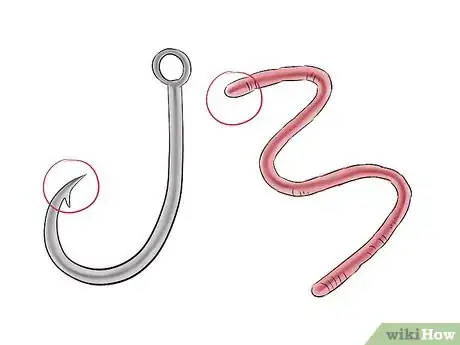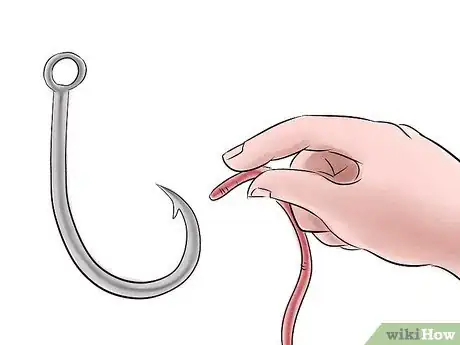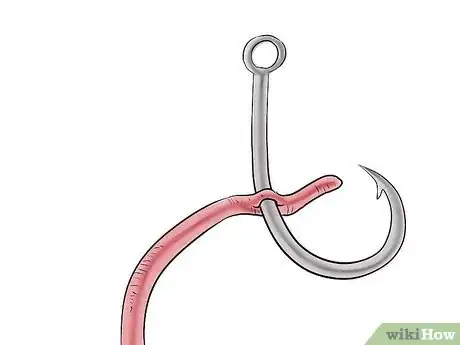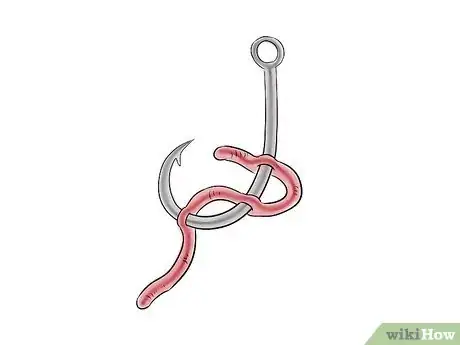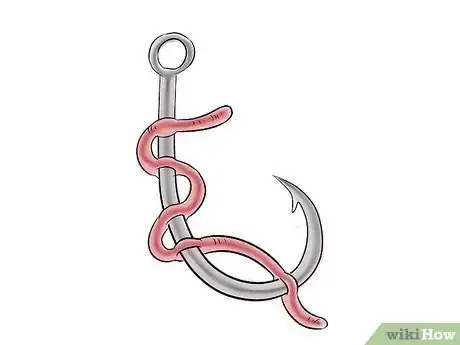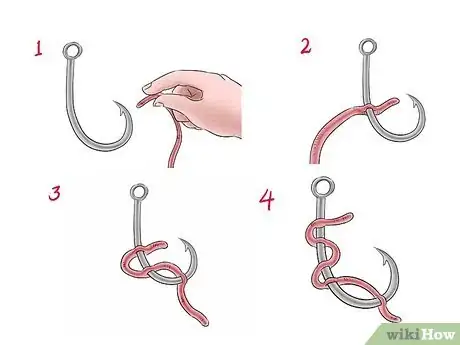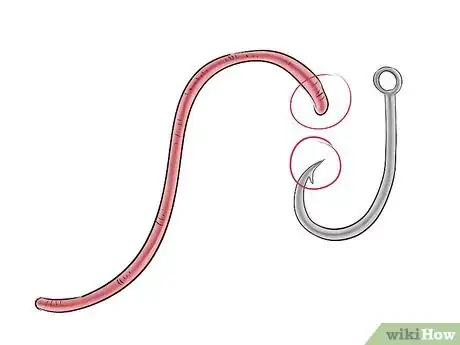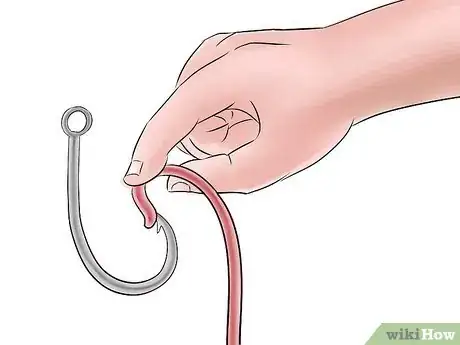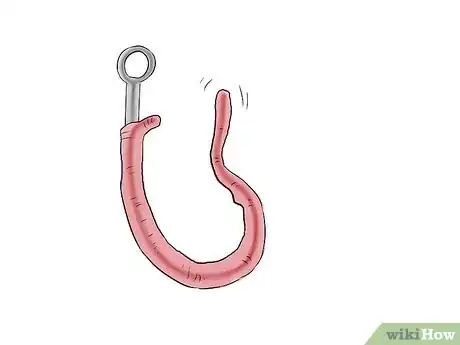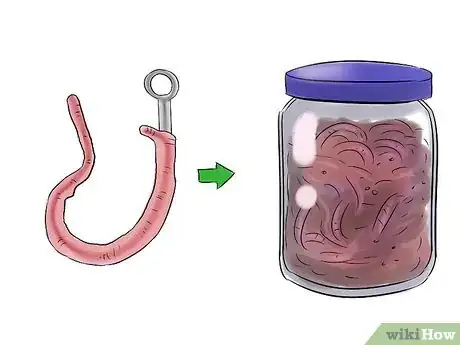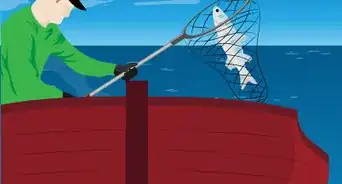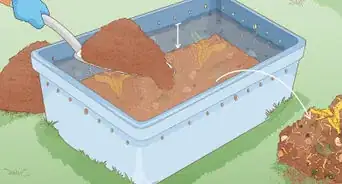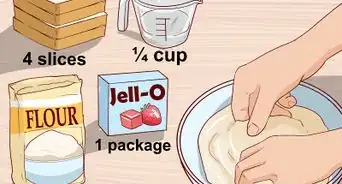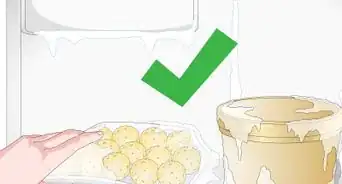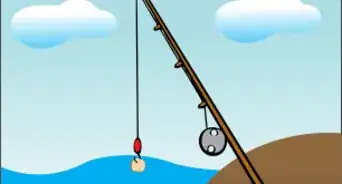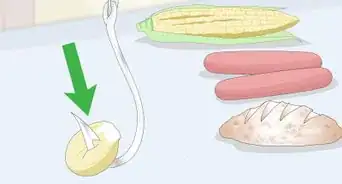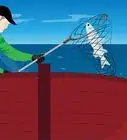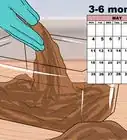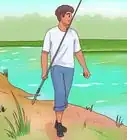wikiHow is a “wiki,” similar to Wikipedia, which means that many of our articles are co-written by multiple authors. To create this article, 17 people, some anonymous, worked to edit and improve it over time.
This article has been viewed 267,098 times.
Learn more...
A worm on your hook isn't any good to you if it wiggles off with every cast. Get the most out of your worms with this how-to guide. You'll learn how to hook a worm quickly and easily so that it stays on the hook until you get the that bite!
Steps
Standard Baiting
-
1Grab a worm and a hook. Before you go fishing, you should buy a container of worms or dig some up from your garden. Keep them in a small container full of cool dirt - Tupperware works well. Only bring your worms out when you're ready to use them. Make sure your hook is well-secured to your fishing line.[1]
- For tips and tricks on finding your own worms, see our How to Gather Earthworms guide. For help tying your hook to a fishing line, see How to Tie a Fishing Knot.
-
2Stick the barbed end of the hook into the end of the worm so that it passes all the way through. Pick a spot about half a centimeter from one end of the worm. Too close to the worm's head, and he might be able to wiggle away from the hook. Take care not to hook your hand as the hook passes through the worm's body - don't press directly down onto the hook's point through the worm.
- No need to be squeamish! Though the worm may squirm and thrash when you hook it, scientists believe that worms can't feel pain.[2]
Advertisement -
3Push the worm to the top of the hook. Slide the worm up the hook in the same way you would slide a bracelet up your arm. Position the speared worm so that it's just below the hook's knot.[3]
- To further secure the worm, some fishermen tie the short end of the speared worm to the fishing line with a simple knot called a half hitch . To perform a half hitch knot, loop the fishing line around your worm, passing the line through the loop. Tighten to secure the worm to the line.
-
4Grab the long end of the speared worm and push the hook through it again. Choose a spot a little further down the length of the worm - your best bet is to leave a little slack so that the "loop" of the worm's body between the two speared spots is slack enough to move a little. Repeat this step going down the length of the worm. When baited, the worm should have an accordion-like appearance.[4]
- The precise number of times you'll need to spear the worm varies based on its length. Generally 3-5 times is plenty.
- Don't spear the very end of the worm. By leaving a little of the worm's length a little "limp," you allow it to wiggle, which catches fish' attention better than a tightly speared worm.
-
5Pull the worm down onto the hook. If your worm is bunched up near the hook's knot, move it down to the "curve" of the hook. You want the fish to bite the hook's barb - if the worm isn't anywhere near the barb, a fish might be able to get a free meal!
-
6Cast away! Repeat this process as needed when you lose a worm or catch a fish. Practice makes perfect - it can be tough to spear squirmy, slimy worms at first, but within no time you'll be baiting worms like a pro angler. Happy fishing!
"Sock" Baiting
-
1Pierce a worm with the hook just behind its head. Don't push the hook all the way through - the hook should be inside the worm's body but not coming the other side. This method of baiting is a little more difficult and increases the chance that a fish will take your worm without biting the hook, but it's much more attractive to fish. You'll go through more worms this way, but you'll also get more bites.[5]
-
2Slowly and carefully push the hook through the worm's body lengthwise. Work the worm around the hook's curve like you'd push a sock up your leg. This step is difficult - be careful not to split the worm in half by pulling the hook's barb through the worm's body again.[6]
-
3When the worm's head is all the way up the length of the hook, stop. Pierce the point of the hook through the worm so that it's sticking out of its side. Allow the rest of the worm's body to dangle limply below the hook. Because so much of the worm is allowed to hang free of the hook, the worm's wiggling will be much more visible to fish in the water than in the standard method. It's also easier for fish to take the "free" portion of the worm without biting the hook. This method is high-risk, high reward.[7]
-
4Cast! If you're using this method, make sure you have plenty of worms handy - you'll go through them quickly. If you can't seem to get the hang of it and keep splitting your worms in half, you can still use the torn segments of worm as bait by simply by spearing them on the hook just under the barb.
Community Q&A
-
QuestionHow do I kill the worm before I start to torture it?
 Community AnswerYou can't do this without butchering the worm to the point that it's unusable for fishing - defeating the purpose of killing it in the first place. Also, the movement of a live worm on the hook helps attract fish.
Community AnswerYou can't do this without butchering the worm to the point that it's unusable for fishing - defeating the purpose of killing it in the first place. Also, the movement of a live worm on the hook helps attract fish. -
QuestionWhere are good places to find worms in the garden?
 Community AnswerLook for them under rocks and garden pots, or just start digging!
Community AnswerLook for them under rocks and garden pots, or just start digging! -
QuestionHow do I tell which end is the head?
 Community AnswerIt's the pointier, darker end. The back is lighter in color and more blunt.
Community AnswerIt's the pointier, darker end. The back is lighter in color and more blunt.
Warnings
- If you accidentally cut yourself on the hook while baiting a worm, keep the wound clean and rinse with soap and water as soon as possible.
- If the hook is stuck in your skin and you can't get it out, don't panic - consult our how-to guide on removing fishing hooks.
⧼thumbs_response⧽
References
- ↑ https://unclejimswormfarm.com/best-way-to-hook-a-worm/
- ↑ http://www.iol.co.za/scitech/technology/worms-and-crayfish-feel-no-pain-experts-1.233383#.Ul7M2W0s2ho
- ↑ https://unclejimswormfarm.com/best-way-to-hook-a-worm/
- ↑ https://www.dec.ny.gov/outdoor/50859.html
- ↑ https://goneoutdoors.com/117172-effective-put-worm-hook.html
- ↑ https://www.youtube.com/watch?v=x-wxdRTkYqg
- ↑ https://www.youtube.com/watch?v=x-wxdRTkYqg
About This Article
To bait a hook with a worm, take the worm and push its body through the hook about a centimeter from one end. Then slide to worm up the hook, grab the worm’s body and push through the hook again, making sure to leave a little slack so the worm can wiggle. Spear the worm 3-5 more times so it’s secure but leave the tail dangling so the worm looks like it is wriggling through the water. Additionally, make sure the worm is near the end of the hook, so the fish will bite the hook while trying to get the worm. Read the article to learn about sock baiting and why you might want to try it.
